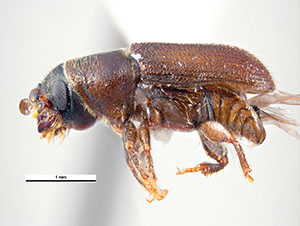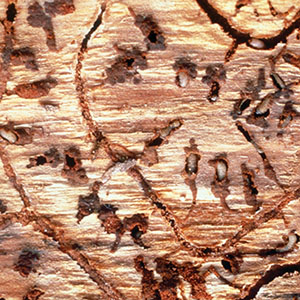The Identity Problem of the Southern Pine Beetle
 |
|
The southern pine beetle, now found as far north as Long Island, is deadly to many species of pine. Source: Pest and Diseases Image Library, Bugwood.org. |
You would think an organism named after the Southern region would stay there. Not so for the southern pine beetle (SPB), which has been wandering northward into the pine forests of New Jersey and neighboring states, causing major destruction to native pine forests. While the name “southern” might not fit this bug anymore, “beetle” still does—along with “prominent tree-killer.” Scientists call it Dendroctonus frontalis. For Matt Ayres, a professor of biological sciences at Dartmouth College, one of his biggest surprises has been how fast recent atmospheric changes have been, and how the SPB invader has taken advantage, turning pines into widows.
He gave a talk at the National Forum on Climate and Pests, sponsored by the Northeastern IPM Center, on October 4. The Center’s website offers a free video of his presentation.
According to Ayres, for enhanced security against the growing numbers of pest species that are expanding their ranges and invading new regions, we need to focus on several factors:
- improved pest monitoring and mitigation
- increased knowledge sharing
- improved biosecurity against future invasions
- management plans that anticipate continuing change
- growth of practical theory that is transportable among forests and regions
“There’s nothing more practical than good theory,” Ayres remarked. “There is already a trove of theories that inform practical management strategies.”
As in the case of SPB, temperatures affect insect survival. Warmer temperatures increase metabolic rates. Temperature affects phenology and species interactions. Ayres gives an example of Arctic mosquitoes, in the presence of warmer temperatures, develop faster than their predators can eat them. It’s a simple example, and population dynamics could go the other way. Unfortunately, in this case, humans lose.
He’s also interested in the idea of phylogenetic conservation of pestilence. This means that pests tend to be members of particular evolutionary groups (clades). Examples are Dendroctonus bark beetles, Agrilus woodborers, autumnal and winter moths, and adelgid plant-suckers. Due to shared genes, creatures within each of these clades are more likely to be plant-killers than most other species of insects.
 |
|
Southern pine beetle damage. Source: Tim Tigner, Virginia Dept. of Forestry, Bugwood.org. |
Ayres noted that we should see more cases of range expansions and invasions by forest pests because of the individual and interacting effects of climate warming, international trade, and human land use.
He showed photos of huge expanses of trees killed within weeks following coordinated attacks by thousands of SPB per tree.
See for example, in his talk, slide 25, of New Jersey pines killed in weeks by D. frontalis.
“Managers can frequently suppress SPB outbreaks by cutting down a band of trees within local infestations where the beetles are highly concentrated,” Ayres said.
He lauds the effective SPB management program in the southeastern states as “one of the greatest success stories in the history of forest pest management.” This program, led by the U.S. Forest Service, is essentially IPM for forests. It includes systematic monitoring with pheromone-baited traps and active suppression when populations first begin to rise, via cutting and removing the trees in which beetles are concentrated. It reduces risk with silvicultural practices such as thinning and controlled burns that reduce the extent of high density (overstocked) pine forests. Otherwise, these forests would become excellent SPB habitat and could rapidly produce enormous populations and regional epidemics.
“We can have more success stories like this,” Ayres commented, “and we will need them because the pests will keep coming.”
Ayres would like to see broader public support for forest management. “Funding for pest management is shrinking and this is a serious problem as the challenges are multiplying and the value of healthy forests is growing,” he said, “but this can be solved because the costs are modest and the benefits large and lasting. We just need more advocates who strongly support forest health in the twenty-first century.”
— by CHRIS GONZALES
The Northeastern IPM Center promotes integrated pest management for reducing risks to human health and the environment. If republishing our news, please acknowledge the source (“From Northeast IPM Insights”) along with a link to our website.
